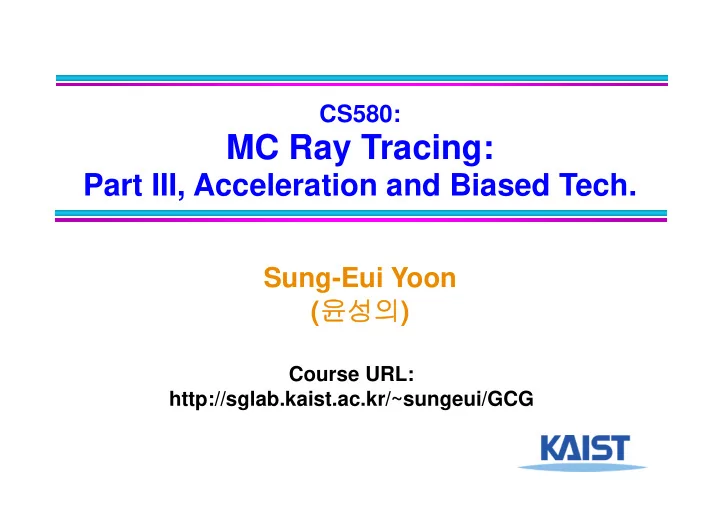

CS580: MC Ray Tracing: Part III, Acceleration and Biased Tech. Sung-Eui Yoon ( 윤성의 ) Course URL: http://sglab.kaist.ac.kr/~sungeui/GCG
Class Objectives: ● Extensions to the basic MC path tracer ● Bidirectional path tracer ● Metropolis sampling ● Biased techniques ● Irradiance caching ● Photon mapping 2
General GI Algorithm ● Design path generators ● Path generators determine efficiency of GI algorithm ● Black boxes ● Evaluate BRDF, ray intersection, visibility evaluations, etc 3
Other Rendering Techniques ● Bidirectional path tracing ● Metropolis ● Biased techniques ● Irradiance caching ● Photon mapping 4
5
6
7
8
9
10
11
Other Rendering Techniques ● Metropolis ● Biased techniques ● Irradiance caching ● Photon mapping 12
Metropolis ● Based on Metropolis sampling (1950’s) ● Introduced by Veach and Guibas to CG ● Deals with hard to find light paths ● Robust ● Hairy math, but it works ● Not that easy to implement 13
Metropolis ● Generate paths ● Once a valid path is found, mutate it to generate new valid paths ● Advantages: ● Path re-use ● Local exploration: found hard-to-find light distribution, mutate to find other such paths 14
15
16
17
18
Metropolis ● Advantages ● Robust ● Good for hard to find light paths ● Disadvantage ● Slow convergence for many important paths ● Tricky to implement and get right 19
Unbiased vs. Consistent ● Unbiased ● No systematic error ● E[I estimator ] = I ● Better results with larger N ● Consistent ● Converges to correct results with more samples ● E[I estimator ] = I + ε , where lim n ∞ ε = 0 20
Biased Methods ● MC methods ● Too noisy and slow ● Nose is objectionable ● Biased methods: store information (caching) ● Irradiance caching ● Photon mapping 21
Irradiance Caching ● Introduced by Greg Ward 1988 ● Implemented in RADIANCE ● Public-domain software ● Exploits smoothness of irradiance ● Cache and interpolate irradiance estimates 22
Irradiance Caching ● Indirect changes smoothly. 23 From Wang’s slides
Irradiance Caching ● Indirect changes smoothly. ● Cache irradiance. 24 From Wang’s slides
Irradiance Caching ● Indirect changes smoothly. ● Cache irradiance. 25 From Wang’s slides
Irradiance Caching ● Indirect changes smoothly. ● Cache irradiance. ● Interpolate them. 26 From Wang’s slides
Irradiance Caching Approach ● Irradiance E(x) estimated using MC ● Cache irradiance when possible ● Store in octree for fast access ● When do we use this cache of irradiance values? 27
28
Indirect Indirect Direct From thesis of Jarosz 29
Photon Mapping ● 2 passes: ● Shoot “photons” (light-rays) and record any hit-points ● Shoot viewing rays and collect information from stored photons 30
31
Flux for each photon 32
for diffuse materials 33
Stored Photons Generate a few hundreds of thousands of photons 34
35
Radiance Estimation ● Compute N nearest photons ● Consider a few hundreds of photons ● Compute the radiance for each photon to outgoing direction ● Consider BRDF and ● Divided by area 36
Efficiency ● Want k nearest photons ● Use kd-tree ● Using photon maps as it create noisy images ● Need extremely large amount of photons 37
Perform direct illumination for visible surface using regular MC sampling 38
Specular reflection and transmission are ray traced 39
40
41
for the caustic 350K photons map Result 42
Progressive Photon Mapping [Hachisuka et al., SIG. A. 08] ● Photon mapping ● A consistent algorithm and good at caustics and SDS paths ● Requires huge # of photons to avoid noises Img.blog.yahoo.co.kr/ybi 43
Progressive Photon Mapping [Hachisuka et al., SIG. A. 08] ● Photon mapping ● Requires huge # of photons to avoid noises ● Its quality is limited by the available memory 22 hours 20M photons 165M photons 44
Overall Framework ● Achieve arbitrary accuracy without requiring infinite memory ● Uses multiple phases ● Store extra information for all the hit points along all the ray paths ● E.g., accumulated # of photons, flux, and current radius 45
Key Idea ● We want to increase # of photons and reduce radius while keeping photon density ● Key assumption: ● Uniform photon density and illumination within each radius 46
213M photons Results 47
Comparison 48
Future Work ● Stopping criteria and error estimate ● How many photons do we need? ● Adaptive photon tracing ● We know how many photons are used in each hit point in the PPM framework 49
Class Objectives were: ● Extensions to the basic MC path tracer ● Bidirectional path tracer ● Metropolis sampling ● Biased techniques ● Irradiance caching ● Photon mapping 50
Summary ● Two basic building blocks ● Radiometry ● Rendering equation ● MC integration ● MC ray tracing ● Unbiased methods ● Biased methods 51
Summary 52
Recommend
More recommend